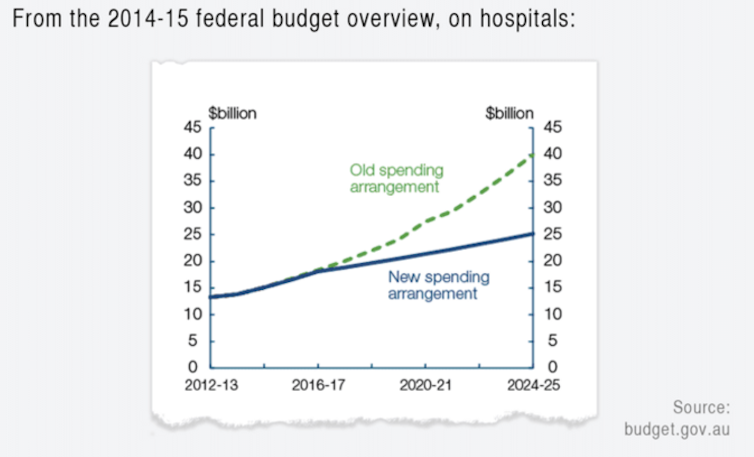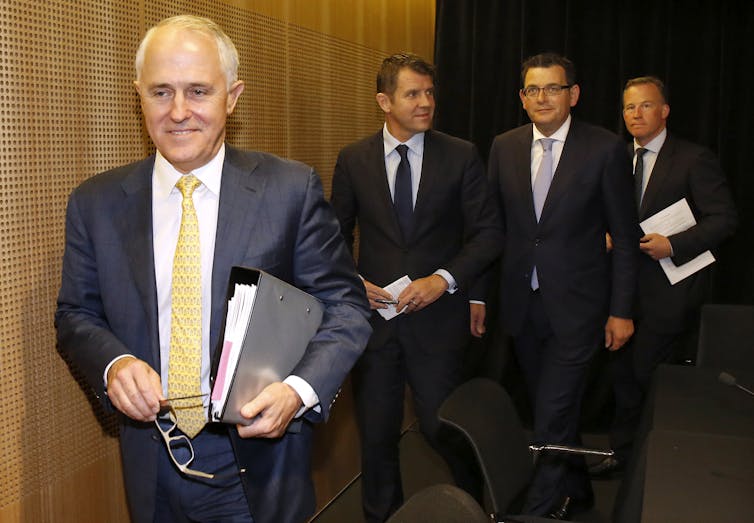Once again, states and territories are mired in negotiations with the Commonwealth about public hospital funding.
The states are still coping with the fiscal shock delivered by the 2014 budget. This foreshadowed the end of the deal on public hospital funding achieved by the 2011 National Health Reform Agreement. Under that agreement, the Commonwealth agreed to fund 55% (initially 45%) of the growth in hospital activity, based on the “nationally efficient price” of providing that service.
The 2014 budget reduced the Commonwealth commitment, from 2017, to growth based on population and inflation.

Meanwhile, the Commonwealth budget has been sliding further into deficit. So now the Commonwealth is telling the states to fix their own hospital budget problems, as though state governments can simply find savings from other areas of expenditure (such as schools) or by cutting public hospital budgets without substantially reducing health-care access or quality.
The sustainability of health expenditure is a long-term challenge. Health-care services are going to cost more, driven by expensive developments in treatments, more demanding populations and rising national wealth. As countries and individuals grow wealthier, they will choose to spend relatively more on health care, particularly on services that improve their quality of life.
Australia’s health funding is essentially an insurance pool, operated by government: it collects revenue from taxpayers and pays out when people need care. So how do we ensure the contributions are fair and generate enough revenue?
We propose a broader, Medicare-style levy for those who pay income tax and the introduction of a wealth-based funding scheme for those with assets and little income. These funds would be earmarked for health services controlled by both the Commonwealth and the states, including public hospitals.
Fair contributions: the argument for a wealth tax
Financing health care through income taxes is generally considered equitable, as it results in a redistribution of health service purchasing power from high-income, healthier groups to low-income groups with poorer health. This is the primary tax base in Australia.
However, one of the consequences of an ageing population is a greater proportion of the population not participating in the workforce and therefore contributing less to the tax base.
The cross-subsidy from the working-age population to the elderly is not a large impost when the relative size of the elderly population is small. But as the dependency ratio falls, it becomes significant.

This is an inter-generational equity issue: how to ensure each generation pays its fair share. On this basis, we argue it’s time for this group to contribute more to national health-care funding.
Australian baby boomers may become income-poor but are generally asset-rich, particularly those who have benefited from rapidly rising house prices and generous superannuation concessions. For this older age group, a wealth tax rather than an income tax more accurately reflects a contribution according to means.
This could take the form of a new national health funding scheme applied to the value of household assets. This scheme would work on an individual basis and pay for the health care that the patient requires, including hospitals, pharmaceuticals and medical services.
If this funding scheme were required to be paid “as you go”, as income tax, it would have the same disadvantages as relying on financing health care through out-of-pocket sources. It presents a real challenge for those with low cash flows but with assets tied up in difficult-to-realise forms, such as the family home.
Therefore, we suggest there be an option to implement this through a resource-contingent loan. The best-known example of this approach is the Higher Education Contribution Scheme (HECS). Why not a form of reverse HECS to support the costs of the health care that Australians want?
Patients could accumulate debts with the national health funding scheme for their health-care consumption, which is subsequently repaid out of their estate.
A broader Medicare levy, earmarked for health
Our tax system raises finance for governments, then governments determine how to spend those taxes. This gives them flexibility to adjust spending and taxes independently, and that is why it’s so popular with treasurers and finance ministers.
The Medicare levy sounds like it’s the part of our tax system that pays for Medicare, but actually these funds just become part of general revenue.
Both the states and the Commonwealth fund health services; each is limited by its revenue capacity and its range of responsibilities. So, the states’ revenue problem is linked to the costs and volume of growth in public hospital activity. Health-care financing is too easily seen as how the states find sufficient capacity to support their hospitals.

A new and broader Medicare levy could be designed to raise finance dedicated to health care. Such a hypothecated tax (earmarked for a specific purpose) and a national funding pool would provide a different type of flexibility to move funds to the most cost-effective and appropriate services at the right time.
This flexibility has been remarkably difficult to achieve in Australia’s federated system. Indeed, one of its clear advantages would be to shift the debate away from a political argument between the state and federal governments, and towards an evidence-based approach to providing effective and efficient care.
In terms of how much a new health-care levy would cost consumers, we don’t have a figure in mind. This would need very careful modelling and cannot be done with back-of-the-envelope calculations.
Time for bold thinking
Improving the efficiency of the health system requires flexibility in how funds are allocated.
Under our proposal, funds would be channelled into a national funding pool earmarked for health care. This would enable the flexibility to direct funds where they’re needed in the system and to deliver services around the patient rather than moving the patient to the funding program.
It is clear from experience around the world that health services should be redesigned from a focus on acute, time-limited problems and diseases to people with chronic and complex conditions requiring ongoing care inside and outside the hospital.
Reform of the tax system, reform of the federation and a new round of health-care reform are all live issues. Time to think about this old problem in a new way.
This article is part of our series Hospitals in Australia. Click on the links below to read the other instalments:
The problems with Australia’s hospitals – and how can they be fixed
From triage to discharge: a user’s guide to navigating hospitals
How much?! Seeing private specialists often costs more than you bargained for
Why do we wait so long in hospital emergency departments and for elective surgery?
Do you really need to go to hospital? Time to recentre the health system
No-one should get dud hospital care – it’s time to lift our game on quality and safety
Hospitals don’t need increased funding, they need to make better use of what they’ve got

